Why Safety Observation Programmes Fail & How to Fix Them
Five Reasons SOR Programmes Don’t Deliver Insights
Safety Observation Reports (SORs) are a cornerstone of many safety management systems. Also known as Hazard Reports or other acronym-based variations, these reports are designed to capture frontline safety concerns and drive corrective action.
Safety Observation Reports (SORs) provides a vehicle for raising safety concerns for immediate and follow-up actions. Where calibrated appropriately, they can also offer insights into the trends of safety concerns and opportunities for improved hazard control measures.
But do Safety Observation Reports actually provide meaningful analytics?
The short answer is yes—when implemented correctly. Within a well-structured safety program, Safety Observation Reports generate valuable data that reflect both past performance trends and predictive insights into future risks.
Attitudes toward their use vary across industries—some organisations treat them as routine checkboxes with little real value, while others consider them a crucial tool for accident prevention. Some overestimate their predictive analytics capabilities, while others take a cautious approach, recognising the risks posed by data gaps and their impact on reliable forecasting.
When incorporated as part of a suite of tools for continuous safety monitoring, SORs can serve as both key performance indicators and early warning signals for potential accidents or losses.
Many SOR programmes function as basic communication tools for continuous improvement. However, to unlock their full analytics value, they must be intentionally designed and implemented for that purpose. Below are five key reasons why Safety Observation Reports often fail to generate meaningful insights—and how to fix them.
Lack of Integration Weakens Safety Observation Reports
The primary reason Safety Observation Report (SOR) programmes fail to evolve from basic reporting tools to predictive analytics is their lack of deep integration with other operational programmes. When the integration is superficial, the programme is unlikely to deliver meaningful insights or drive proactive safety improvements.
Most management systems include safety observations as a standard element, but this does not mean they are strategically aligned with other programmes.
In reality, very few safety teams managing SOR programmes have a comprehensive understanding of the operational schedule—upcoming activities, delays, rescheduling, and other key factors—needed to tailor and refine the observation process.
A quick way to test the extent of a SOR programme integration is to assess how informed the safety team is about the overall programme of works. Are they aware of changes in scheduling, critical operations, delays, and emerging risks on the horizon?
If the safety programme architect is not fully immersed in the day-to-day workings of the operation, the observation programme risks becoming an isolated exercise, disconnected from real-time needs. Still functional as a reporting tool but ineffective as an analysis tool.
However, when the safety programme architect is closely aligned with the broader operation—so much so that others look to them for updates—the safety observation programme, and the safety system as a whole, benefit tremendously.
One of the most immediate advantages of this deeper integration is the ability to plan targeted observations that align with specific operational activities, shifting the approach from opportunistic spot-checks to a structured, systematic review process.
A fully integrated SOR programme also transforms senior management site walks from routine visits—where every participant simply notes that "housekeeping could be improved"—into meaningful, high-value engagements. Such visits become opportunities for leadership to provide insightful feedback on key aspects of operations, leveraging their fresh perspectives as visitors to the site.
Opportunistic vs. Planned Observations: A Key Reporting Weakness
The second major reason why safety observation programmes often fail to provide genuine analytics value is the imbalance between ad-hoc observations and structured, planned observations.
When an unsafe condition is reported simply because someone happened to be in the area at the time, it carries a different level of value compared to an issue identified during a planned inspection. The former is an opportunistic observation, while the latter is a confirmation of a hypothesis—yielding stronger insights and more meaningful data.
For example, on a construction site, the lifting and installation of precast concrete panels may be scheduled for inspection, with the specific goal of assessing compliance with safety standards and identifying areas for improvement.

Safety Observation Reports generated from such planned inspections provide deeper value compared to random, opportunistic observations. Planned observations offer a broader view of what works well and what does not.
They reveal shortcuts teams may take—some of which could be beneficial and optimised to improve overall safety. They also highlight inefficiencies in approved safe methods and the unintended hazards they introduce. A well-planned observation process does more than improve Safety Observation Reports; it transforms the entire safety programme.
That said, opportunistic observations are not inherently inferior and should still be encouraged. However, tracking the percentage of opportunistic versus planned observations can help refine the overall safety programme.
The Safe Method Variation pioneered at SafetyRatios is designed to record the outcomes of planned task observations, classifying them into positive ones that while varied from the approved method actually provides opportunity for improving the approved method of work. And negative ones that increase the risk of accident / loss and the reliability of other control measures.
The simplest and most effective way to enhance the relevance and value of the Safety Observation Report programme is to incorporate Planned Task Observations (PTO). These structured observations focus on entire tasks, capturing both positive and negative aspects to provide a more balanced and insightful assessment.
Selective Reporting Limits Data Accuracy in SOR Programmes
The third reason an SOR programme may fail to transcend being a reporting tool relates to the extent of selective reporting and how the collected data is generalised as an indicator of performance trends.
A fundamental principle of data analytics is that cleaner, larger datasets generally yield better analyses and more actionable insights.
However, since reporting every detail takes time and effort, most SOR programmes rely on observers selectively reporting what they subjectively deem significant.
This subjectivity undermines the objectivity of the data, limiting its potential for robust analysis.
A safety programme can function effectively with selective hazard reporting—if it is designed that way. The issue arises when incomplete data is presented as a comprehensive reflection of overall performance and then used for predictive analysis.
For example, an increase in positive observations is meaningless without a baseline that accounts for the expected number of observations based on a rigorous analysis of planned tasks. Similarly, reporting that high-risk observations have dropped from 40 to 10 per month is a relative measure with no analytic value unless contextualised against expected trends and operational changes.
For Safety Observation Reports to have analytical value, they must be designed with that purpose in mind, ensuring data is collected objectively and consistently.
The most effective way to enhance the analytical value of Safety Observation Reports is to maintain the existing programme for operational control while introducing a parallel programme that systematically gathers comprehensive observation data through planned task observations. Use monitoring data for real-time oversight and structured data for in-depth analysis.
Underreporting of Positive Observations Skews Safety Metrics
The fourth reason Safety Observation Reports fail as effective analytics tools is the selective and subjective reporting of "good" safety observations.
Positive observations often appear in the data suddenly and then taper off just as quickly. They are typically introduced when management requests their inclusion and fade away when such demands lessen.
Reporting safety concerns is already a challenge; expecting teams to consistently report good observations is an even higher bar. Many employees are accustomed to negative observations triggering corrective actions that benefit the operation, but often question the purpose of reporting positive observations beyond mere recognition.
If good observations are only collected for weekly reports or to highlight team performance, their value remains limited. Consequently, maintaining consistent reporting of positive observations becomes an uphill battle.
However, when integrated into the broader safety programme, positive observations can provide valuable insights that drive continuous improvement across the organisation.
To elevate Safety Observation Reports from simple reporting tools to meaningful analytics tools, structured inspection programmes should be implemented. These should consistently capture both positive and negative observations in a systematic manner, ensuring a comprehensive dataset that supports informed decision-making.
Misrepresentation of Safety Data Undermines Decision-Making
The final reason Safety Observation Reports fail to provide meaningful analytics value is a culmination of all the other issues discussed.
The primary value of most safety observation programmes is the ability to document hazards and take corrective actions. This is an essential function that should not be undervalued.

However, attempting to aggregate this data over time or across operational areas to identify trends often extends its usefulness beyond what the dataset can reliably support.
Data analytics and trend analysis are only valuable when the data is systematically collected, large enough for meaningful analysis, and free from significant inconsistencies.
Relying on subjectively gathered observations—often incomplete and inconsistent—introduces risks of drawing false conclusions that could misguide decision-making and derail the broader safety programme.
Ultimately, the five major reasons Safety Observation Reports struggle to move beyond a simple compliance-monitoring tool can be overcome through thoughtful redesign and repurposing.
Safety Observation Reports are an invaluable tool for tracking compliance with safety standards, but unless they are deliberately designed for analytical purposes, they rarely deliver the full insights organisations need to enhance safety performance.
At SafetyRatios, we bridge the gap between frontline safety observations and data-driven safety metrics to improve workplace safety. This article examines why Safety Observation Reports (SORs) often fail to generate meaningful insights and how to optimise them for real impact. For solutions that enhance safety data tracking and predictive analytics, visit our Solutions Page and explore our metrics-driven safety tools.